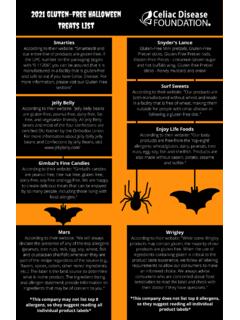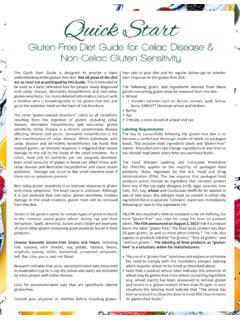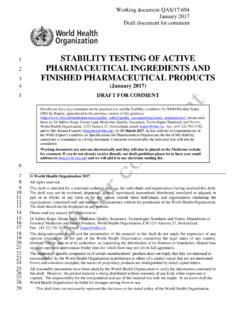Transcription of Medications and Celiac Disease— Tips From a Pharmacist
1 PRACTICAL GASTROENTEROLOGY JANUARY 200758 Medications and Celiac disease tips From a PharmacistINTRODUCTION Patients who have been diagnosed with Celiac dis-ease (CD) or have a need to follow a gluten-free(GF) diet must be aware of potential sources ofgluten. In the area of pharmaceuticals, potentialsources of gluten contamination come primarily fromthe addition of the excipient (filler) ingredients addedto the active drug in order to make a particular dosageform. Gluten ingestion in a patient with Celiac Diseasecauses an immunologically mediated inflammatoryresponse, which results in damage to the mucosa of thesmall intestine.
2 It requires only a relatively smallamount of the gluten to illicit this response so it isimportant to avoid the exposure (1,2). Excipients form the bulk of the product and aredesigned to perform several functions. In addition toproviding bulk, they may be utilized as lubricants forthe powder, or as in the case of starches, absorb water,which causes the tablet to swell and disintegrate. It isthese starches that provide the potential source ofgluten contamination. These excipients can be obtainedfrom any starch source, but are primarily derived fromTHE Celiac DIET, SERIES #5 Steven Plogsted, , BCNSP, Clinical Pharma-cist, Nutrition Support Service, Columbus Children sHospital, Clinical Assistant Professor of Pharmacy,Raabe College of Pharmacy, Ohio Northern Univer-sity, Columbus, Rees Parrish, , , Series EditorCeliac disease is a chronic, generically linked, autoimmune disorder that is also knownas Celiac sprue, nontropical sprue, and gluten-sensitive enteropathy.
3 Although celiacdisease primarily affects the small intestine, deleterious effects can occur throughoutthe entire body. Patients with Celiac disease are unable to tolerate the ingestion ofgluten. Gluten is an insoluble protein found in all cereal grains. The gluten that is foundin wheat, rye, and barley is the offending culprit for Celiac disease patients. The preva-lence in the United States is estimated to effect 1% of the population. The followingarticle is designed to help identify Medications that may contain Plogsted(continued from page 60)PRACTICAL GASTROENTEROLOGY JANUARY 200760 THE Celiac DIET, SERIES #5 Medications and Celiac disease tips From a Pharmacist (continued from page 58)Table 1 Common Excipient ingredients in Medications Benzyl alcoholmade synthetically from benzyl chloride which is derived from toluene (a tar oil)Cellulose(methylcellulose, hydroxymethylcellulose, microcrystalline, powdered) obtained from fibrous plant material(woody pulp or chemical cotton)
4 Cetyl alcoholderived from a fat source (spermaceti, which is a waxy substance from the head of the sperm whale)Croscarmellose sodiuman internally cross-linked sodium carboxymethylcellulose for use as a disintegrant in pharmaceutical formulations. It contains no sugar or moleculesDetratesmix of sugars resulting from the controlled enzymatic hydrolysis of starchDextrinsresult from the hydrolysis of starch (primarily corn or potato) by heat or hydrochloric acid. It can also beobtained from wheat, rice or tapiocaDextri-maltoseA sugar that may be obtained from barley maltDextroseA sugar that is obtained from corn starchFructoseA sugar also known as levulose or fruit sugar GelatinObtained from the skin, white connective and bones of animals (by boiling skin, tendons, ligaments, bones, etcwith water)GlycerinHistorically, glycerin (also known as glycerol), was made the following ways.
5 Saponification (a type of chemical process) of fats and oils in the manufacturing of soaps Hydrolysis of fats and oils through pressure and superheated steam Fermentation of beet sugar molasses in the presence of large amounts of sodium sulfite Today it is made mostly from propylene (a petroleum product)Glycerolsobtained from fats and oils as byproducts in the manufacture of soaps and fatty acids (may also be listed asmono-glycerides or di-glycerides)Glycolsproducts of ethylene oxide gasIron oxide (rust)used as a coloring agentKaolinA clay-like substance LactilolLactose derivativeLactoseLactose, or milk sugar, is used in the pharmaceutical industry as a filler or binder for the manufacture ofcoated pills and tabletsMaltodextrinA starch hydolysate that is usually obtained from corn but can also be extracted from wheat, potato or riceMannitolderived from monosaccharides (glucose and mannose)Polysorbateschemically altered sorbitol (a sugar)
6 Povidone synthetic polymers (crospovidone)Pregelatinized starchA starch that has been chemically or mechanically processed. The starch can come from corn, wheat, potatoor tapiocaShellacA natural wax product used in tablet or capsule coatingSodium lauryl sulfatederivative of the fatty acids of coconut oilSodium starch glycolateA starch that is usually obtained from potato but may come from any starch sourceStearates (calcium, derived from stearic acid (a fat; occurs as a glyceride in tallow and other animal fats and oils, as well as magnesium)some vegetables.)
7 Prepared synthetically by hydrogenation of cottonseed and other vegetable oils)SucroseRefined sugar also known as refined sugar, beet sugar or cane sugarcorn, potato and tapioca; however, they have also beenknown to contain starch from wheat. There are a fewproducts that are clearly labeled as GF, however, themajority of the manufacturers do not provide that infor-mation on either the package or the package OF THE FOOD AND DRUG ADMINISTRATIONThe United States Food and Drug Administration(FDA) is responsible for overseeing the safe manufac-turing of drug products.
8 While they maintain strict reg-ulations for the active ingredient of the drug product, they provide minimal over-site for what excipients canbe added. The drug manufacturers must utilize onlyFDA approved excipients, but the quantity and type ofexcipient is not specifically regulated. This is impor-tant to understand, especially in the manufacturing ofgeneric drug products, since generic product does nothave to contain the same excipients as the brand generic drug manufacturers must demon-strate certain absorption characteristics when theyreproduce a drug, but all other aspects can TO CALL THE DRUG MANUFACTURER Where can a consumer or health care professionalobtain the necessary drug information?
9 Can this infor-mation be trusted? The consumer or health care pro-fessional needs to consider two questions when aninquiry is made about the gluten content of a drug. Thefirst question is what are the inactive ingredients orexcipients? Excipients are listed in the package insertand should be the first place a Pharmacist looks forinformation (Table 1). Once the excipients are read thesecond question that should be asked is, what is thesource of the ingredient? Again, the package insertprovides the Pharmacist with the starting point.
10 One ofthe first key words to look for in the inactive ingredi-ents section is starch. As mentioned previously, starchcan be derived from several sources including corn,potato, tapioca, and wheat. If the product lists starch as cornstarch or starch (corn) it can be assumed to beGF. If starch by itself is listed, a call to the manufac-turer is the only wayto confirm the source of thestarch. Other common terms include pregelatinizedstarch and sodium starch glycolate. Both products arestarches derived from corn, wheat, potato, or rice,however, they have been chemically treated orprocessed.





